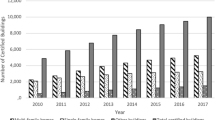Abstract
The statistics, finance, and real estate literature regularly rely on propensity score matching techniques to balance samples of data where randomized treatment assignment is not possible. In the sustainable commercial real estate literature the technique has seen substantive use. To analyze price and rent premiums for green buildings, several studies have used propensity scores to ensure samples that contains eco-labeled and un-labeled buildings reflect a randomized assignment of the treatment. Underpinning the argument for the use of propensity scores is the notion that green buildings contain similar attributes to non-green buildings. However, if the green labels were ignored, would premium buildings be otherwise statistically similar to premium buildings in the market? Here, we analyze a research question focusing on the extent to which propensity scores can predict a green building using the standard building attributes and whether propensity scoring is an econometric necessity?
Similar content being viewed by others
References
Barrett, L., Glick, S., Clevenger, C. (2011). The Process for Adopting an Energy Efficiency Code in Existing Homes: A Case Study of Boulder, Colorado’s SmartRegs Program. The Journal of Sustainable Real Estate, 3(1), 192–210.
Benjamin, J.D., Chinloy, P., Jud, G.D. (2004). Real estate versus financial wealth in consumption. The Journal of Real Estate Finance and Economics, 29(3), 341–354.
Bonde, M., & Song, H.-S. (2013). Does greater energy performance have an impact on real estate revenues? Journal of Sustainable Real Estate, 5(1).
Bradshaw II, W.B. (2011). Creative Construction: the capacity for environmental innovation in real estate development firms. The Journal of Sustainable Real Estate, 3(1), 274– 311.
Brounen, D., & Kok, N. (2010). On the Economics of Energy Labelling in the Housing Market. Journal of Environmental Economics and Management.
Caliendo, M., & Kopeinig, S. (2008). Some practical guidance for the implementation of propensity score matching. Journal of economic surveys, 22(1), 31–72.
Chegut, A., Eichholtz, P., Kok, N. (2014). Supply, demand and the value of green buildings. Urban Studies, 51(1), 22–43.
Costa, D.L., & Kahn, M.E. (2010). Energy conservation ”nudges” and environmentalist ideology: Evidence from a randomized residential electricity field experiment. National Bureau of Economic Research.
Das, P., & Wiley, J.A. (2013). Determinants of premia for energy-efficient design in the office market. Journal of Property Research (ahead-of-print), pp. 1–23.
Dehejia, R.H., & Wahba, S. (2002). Propensity score-matching methods for nonexperimental causal studies. Review of Economics and statistics, 84(1), 151–161.
Dermisi, S.V. (2009). Effect of LEED ratings and levels on office property assessed and market values. The Journal of Sustainable Real Estate, 1(1), 23–47.
Ding, L., Quercia, R.G., Li, W., Ratcliffe, J. (2011). Risky Borrowers or Risky Mortgages Disaggregating Effects Using Propensity Score Models. Journal of Real Estate Research, 33(2), 245–277.
Eichholtz, P., Kok, N., Quigley, J. (2011). The Economics of Green Buildings. Journal of Sustainable Real Estate, 1(1).
Eichholtz, P., Kok, N., Quigley, J.M. (2009). Why do companies rent green. Real Property and Corporate Social, 22.
Eichholtz, P., Kok, N., Quigley, J.M. (2010a). Doing well by doing good? Green office buildings. The American Economic Review, 2492–2509.
Eichholtz, P., Kok, N., Quigley, J.M. (2010b). Why Do Companies Rent Green? Real Property and Corporate Social Responsibility.
Fuerst, F., & McAllister, P. (2009). An investigation of the effect of eco-labeling on office occupancy rates. The Journal of Sustainable Real Estate, 1(1), 49–64.
Fuerst, F., & McAllister, P. (2011). Green noise or green value? Measuring the effects of environmental certification on office values. Real Estate Economics, 39(1), 45–69.
Gottesman, A.A., & Roberts, G.S. (2007). Loan rates and collateral. Financial Review, 42(3), 401–427.
Grinstein-Weiss, M., Key, C., Yeo, Y.H., Yoo, J., Holub, K., Taylor, A., Tucker, J. (2012). Homeownership, Neighbourhood Characteristics and Children’s Positive Behaviours among Low-and Moderate-income Households. Urban Studies, 49(16), 3545–3563.
Jaffee, D., Stanton, R., Wallace, N. (2012). Energy factors, leasing structure and the market price of office buildings in the US.
Kok, N., McGraw, M., Quigley, J.M. (2011). The diffusion of energy efficiency in building. The American Economic Review, 101(3), 77–82.
Luellen, J.K., Shadish, W.R., Clark, M. (2005). Propensity Scores An Introduction and Experimental Test. Evaluation Review, 29(6), 530–558.
Miller, N., Spivey, J., Florance, A. (2008). Does green pay off? Journal of Real Estate Portfolio Management, 14(4), 385–400.
Nanda, A., & Ross, S.L. (2012). The impact of property condition disclosure laws on housing prices: Evidence from an event study using propensity scores. The Journal of Real Estate Finance and Economics, 45(1), 88–109.
Oates, D., & Sullivan, K.T. (2011). Postoccupancy energy consumption survey of Arizona’s LEED new construction population. Journal of Construction Engineering and Management, 138(6), 742– 750.
Parkinson, A., & Cooke, A. (2012). Market Responses to the Sustainability and Energy Performance of Commercial Property. Sustainability in Energy and Buildings, (pp. 85–97): Springer.
Pivo, G. (2008). Responsible Property Investing: What the Leaders Are Doing. Journal of Property Investment & Finance, 26(6), 562–576.
Pivo, G., & Fisher, J.D. (2010). Income, value, and returns in socially responsible office properties. Journal of Real Estate Research, 32(3), 243–270.
Pivo, G., & Fisher, J.D. (2011). The walkability premium in commercial real estate investments. Real Estate Economics, 39(2), 185–219.
Reichardt, A. (2013). Operating Expenses and the Rent Premium of Energy Star and LEED Certified Buildings in the Central and Eastern US. The Journal of Real Estate Finance and Economics, 1–21.
Rosenbaum, P.R. (2002). Constructing matched sets and strata. Observational studies, (pp. 295–331): Springer.
Rosenbaum, P., & Rubin, D. (1984). Reducing bias in observational studies using subclassification on the propensity score. Journal of the American Statistical Association, 79(387), 516–524.
Simcoe, T., & Toffel, M.W. (2011). LEED Adopters: Public procurement and private certification. Working paper.
Simons, R.A., Choi, E., Simons, D.M. (2009). The Effect of State and City Green Policies on the Market Penetration of Green Commercial Buildings. The Journal of Sustainable Real Estate, 1(1), 139–166.
Simons, R.A., Robinson, S., Lee, E. (2014). Green Office Buildings: A Qualitative Exploration of Green Office Building Attributes. The Journal of Sustainable Real Estate, 6(2), 211–232.
Szumilo, N., & Fuerst, F. (2012). The Operating Expense Puzzle of US Green Office Buildings. Available at SSRN 2166028.
Warren-Myers, G. (2012). The value of sustainability in real estate: a review from a valuation perspective. Journal of Property Investment & Finance, 30(2), 115–144.
Wheaton, W.C., & Torto, R.G. (1994). Office rent indices and their behavior over time. Journal of Urban Economics, 35(2), 121–139.
Wiley, J.A., Benefield, J.D., Johnson, K.H. (2010). Green design and the market for commercial office space. The Journal of Real Estate Finance and Economics, 41(2), 228–243.
Zheng, S., & Cao, Y. (2009). The Determinants of Jobs-Housing Spatial Relationship in Beijing [J]. Urban Studies, 6, 008.
Author information
Authors and Affiliations
Corresponding author
Rights and permissions
About this article
Cite this article
Robinson, S.J., Sanderford, A.R. Green Buildings: Similar to Other Premium Buildings?. J Real Estate Finan Econ 52, 99–116 (2016). https://doi.org/10.1007/s11146-015-9498-z
Published:
Issue Date:
DOI: https://doi.org/10.1007/s11146-015-9498-z




